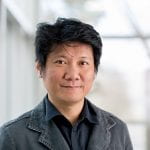
Guest post by Jawshing Arthur Liou.
My son was particularly curious about where he came from when he was 7 or 8. His sister passed away before he was born. There is a black hole in his memory about a person who is supposed to be so close to him and yet remains as an unknown. He pondered the questions about our existence, life, and death while his thoughts were not fully shaped by reason and science yet. Things that are spiritual and magical were all still possible.
I don’t remember my own innocent mind before being conditioned to a common-sense reality. I do remember how the world of reality seemingly crumbled around me when my daughter died. None of my training and knowledge could help me cope with the loss — an experience that was slow and quiet on the outside and abrupt and violent on the inside. It was then I met with the limitation of my world view. I started to seek sanctuary in Buddhism. Being in awe of life like an 8-year-old child again, I felt like I was stumbling through a door where the spiritual and magical made sense once more.
For a long time, my work has been about an improbable space where my thoughts and prayers could be connected to the unknown. That does not mean it is detached from reality. In a surprise collaboration with Alex Straiker, a research scientist at IU, I learned about our brains’ ability to produce the equivalence of THC and CBD, known substances from cannabis plants. Of all the cognitive functions they perform on our body, I was most struck by how they regulate memory — the ability to learn and to forget. Human-Cannabis I: Sonnet 27 presents a pre-historic encounter between human and cannabis. The imageries suggest a primordial force that is both in nature and in our mind. It is a journey of someone’s memories both of a child and as a child, blurred between the lines of remembering and forgetting.
As I turn my attention to the world’s cannabis history and culture, the ancient worship of hemp in Japan is one of the most beautiful and mysterious. In the Shinto coronation ceremony, the emperor wears a hemp robe and receives an offering of hemp as a symbol of the plant realm and silk as a symbol of the animal realm. Hemp rope, paper, and fiber could be seen strung around Shinto temples and spiritual sites. Human-Cannabis II: Asa portrays hemp as a religious medium for the supernatural. The father-daughter relationship is a thinly veiled projection of my wishful thinking. The unsettled timeline is a metaphor for the mirrored images of illusion and reality, a notion of life that continues to imprint on my faith and quandary.
Human-Cannabis I: Sonnet 27 and Human-Cannabis II: Asa will be screened at IU Cinema on April 8. Director Jawshing Arthur Liou is scheduled to be present for a post-screening Q&A moderated by IU Cinema Founding Director Jon Vickers.
Watch the trailer for Human-Cannabis here. To read more about the series, including the science that inspired it, check out Liou’s interview with WFIU’s Yaël Ksander from 2013, when Sonnet 27 was first completed, here.

Jawshing Arthur Liou is an artist with a background in photography, digital media, film, and journalism. His recent projects include a pilgrimage in the sacred mountains in Tibet, a journey through the tsunami-ravaged coastline of Japan, and a cinematic collaboration with a brain scientist regarding the connection between endocannabinoids and memory. Liou works with lens-based materials and electronic imaging to create installations depicting mental and surreal spaces. Many of his videos do not contain clear narratives but are meditative in nature, allowing time to slow to a ruminative pace while spatial scales oscillate between the microcosmic and infinitely expansive. Using sources ranging from landscapes and oil paint to human body, much of Liou’s work is related to notions of impermanence, loss, and spiritual sanctuary.
Liou’s videos and prints have been featured in programs, exhibitions, and collections in Tokyo Metropolitan Museum of Photography; Crystal Bridges Museum of American Art; Rubin Museum in New York; Museum of Fine Arts in Houston; Museum of Contemporary Photography in Chicago; Indianapolis Museum of Art; National Gallery Victoria, Melbourne; Seoul Museum of Art; National Taiwan Museum of Fine Arts; Taipei Fine Arts Museum; Red Brick Museum, Beijing; Art Basel: Hong Kong; and Sharjah Biennial. Liou is the recipient of Asian Cultural Council Grant, New York; Efroymson Contemporary Arts Fellowship, Indianapolis; and Garry B. Fritz Award from the Society for Photographic Education National Conference, Chicago. International presentations of his work include SIGGRAPH conference; European Biennial Conference of the Society for Science, Literature, and the Arts; and Chicago Humanities Festival. Liou is currently the Herman B Wells Professor of Digital Art at Indiana University, Bloomington.